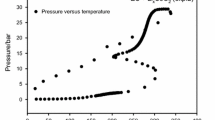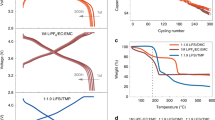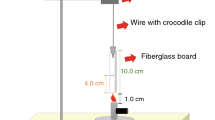Abstract
The thermal instabilities of deposited lithium with electrolytes in lithium-ion batteries are simulated by the reactions between metallic lithium with organic esters and ethers. Exothermic onset temperatures and enthalpy changes are measured and analyzed by differential scanning calorimetry. In this study, heat of reactions in lithium with eight different formations of esters and ethers are determined which are consistent to the data of lithiated graphite (LiC6) reacted with electrolytes in literature. Furthermore, violently exothermic reactions with enthalpy larger than 1,000 J g−1 and onset temperature lower than 120 °C are further conducted by the confinement test to verify the worst scenarios and consequences of lithium-ion batteries encountered any kind of abuses. Thermal instability of metallic lithium with organic esters in descending order determined to be Li + EB (70 °C)>Li + MB (73.1 °C)>Li + EA (90.8 °C). Finally, thermal hazard data such as onset temperature, maximum self-heat rate, maximum temperature, and maximum pressure of lithium reacted with esters and ethers are compared, evaluated, and some conclusion and suggestions are made.








Similar content being viewed by others
References
Koksbang R, Barker J, Shi H, Saidi MY. Cathode materials for lithium rocking chair batteries. Solid State Ion. 1996;84:1–21.
Whittingham MS. Lithium batteries and cathode materials. Chem Rev. 2004;104:4271–301.
Goodenough JB. Cathode materials: a personal perspective. J Power Sources. 2007;174:996–1000.
Ohzuku T, Brodd RJ. An overview of positive-electrode materials for advanced lithium-ion batteries. J Power Sources. 2007;174:449–56.
Yazami R, Touzain P. A reversible graphite–lithium negative electrode for electrochemical generators. J Power Sources. 1983;9:365–71.
Yazami R, Guerard D. Some aspects on the preparation, structure and physical and electrochemical properties of Li x C6. J Power Sources. 1993;15:39–46.
Mizushima K, Jones PC, Wiseman PJ, Goodenough JB. Li x CoO2 (0 < x < 1): a new cathode material for batteries of high energy density. Mater Res Bull. 1980;15:783–9.
Thomas M, Bruce PG, Goodenough JB. Lithium mobility in the layered oxide Li1−x CoO2. Solid State Ion. 1985;17:13–9.
Nagaura T, Tozawa K. Lithium ion rechargeable battery. Prog Batteries Sol Cells. 1990;9:209–17.
Ozawa K. Lithium-ion rechargeable batteries with LiCoO2 and carbon electrodes: the LiCoO2/C system. Solid State Ion. 1994;69:212–21.
Fong F, Sacken FU, Dahn JR. Studies of lithium intercalation into carbons using nonaqueous electrochemical cells. J Electrochem Soc. 1990;137:2009–13.
Xu K. Nonaqueous liquid electrolyte for lithium-based rechargeable batteries. Chem Rev. 2004;104:4303–417.
Sasaki Y. Organic electrolytes of secondary lithium batteries. Electrochemistry. 2007;76:2–15.
Spotnitz R, Franklin J. Abuse behavior of high-power, lithium-ion cells. J Power Sources. 2003;113:81–100.
Lisbona D, Snee T. A review of hazards associated with primary lithium and lithium-ion batteries. Process Saf Environ Prot. 2011;89:434–42.
Wang Q, Ping P, Zhao X, Chu G, Sun J, Chen C. Thermal runaway caused fire and explosion of lithium ion battery. J Power Sources. 2012;208:210–24.
Tobishima S, Yamaki J. A consideration of lithium cell safety. J Power Sources. 1999;81–82:882–6.
MacNeil DD, Lu Z, Chen Z, Dahn JR. A comparison of the electrode/electrolyte reaction at elevated temperatures for various Li-ion battery cathodes. J Power Sources. 2002;108:8–14.
Venkatachalapathy R, Lee CW, Lu W, Prakash J. Thermal investigations of transitional metal oxide cathodes in Li-ion cell. Electrochem Commun. 2000;2:104–7.
Yamaki J, Baba Y, Katayama N, Takatsuji H, Egashira M, Okada S. Thermal stability of electrolytes with Li x CoO2 cathode or lithiated carbon anode. J Power Sources. 2003;119–121:789–93.
Xia Y, Fujieda T, Tatsumi K, Prosini PP, Sakai T. Thermal and electrochemical stability of cathode materials in solid polymer electrolyte. J Power Sources. 2001;92:234–43.
Zhang Z, Fouchard D, Rea JR. Differential scanning calorimetry material studies: implications for the safety of lithium-ion cells. J Power Sources. 1998;70:16–20.
Jiang J, Dahn JR. Effects of solvents and salts on the thermal stability of LiC6. Electrochem Commun. 2004;6:39–43.
Wang Y, Jiang J, Dahn JR. The reactivity of delithiated Li(Ni1/3Co1/3Mn1/3)O2, Li(Ni0.8Co0.15Al0.05)O2 or LiCoO2 with non-aqueous electrolyte. Electrochem Commun. 2007;9:2534–40.
MacNeil DD, Dahn JR. The reaction of charged cathodes with nonaqueous solvents and electrolytes: I. Li0.5CoO2. J Electrochem Soc. 2001;148:A1205–10.
Watanabe I, Yamaki J. Thermalgravimetry–mass spectrometry studies on the thermal stability of graphite anodes with electrolyte I lithium-ion battery. J Power Sources. 2006;153:402–4.
TA4000 operation instructions. Kusnacht: Mettler Company; 1993.
ASTM E537-07. Standard test method for assessing the stability of chemicals by methods of differential thermal analysis; (2007).
ASTM E476-87. Standard test method for thermal instability of confined condensed phase system (Confinement Test); (1993).
Hsieh TY, Duh YS, Kao CS. Evaluation of thermal hazard for commercial 14500 lithium-ion batteries. 41st North American Thermal Analysis Society (NATAS) Annual Conference, USA, 2013.
Guerard D, Herold A. Intercalation of lithium into graphite and other carbons. Carbon. 1975;13:337–45.
Billaud D, McRae E, Herold A. Synthesis and electrical resistivity of lithium-pyrographite intercalation compounds (stages I, II and III). Mater Res Bull. 1979;14:8357–864.
Tobishima SI, Yamaki JI, Okada T. Ethylene carbonate/ether mixed solvents electrolyte for lithium batteries. Electrochim Acta. 1984;29:1471–6.
Author information
Authors and Affiliations
Corresponding author
Rights and permissions
About this article
Cite this article
Li, Y.C., Duh, Y.S., Hsu, J.M. et al. Thermal instability of organic esters and ethers with deposited lithium in lithium-ion battery. J Therm Anal Calorim 116, 1219–1226 (2014). https://doi.org/10.1007/s10973-014-3689-3
Received:
Accepted:
Published:
Issue Date:
DOI: https://doi.org/10.1007/s10973-014-3689-3




